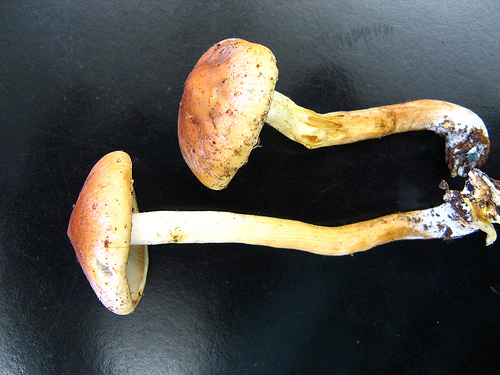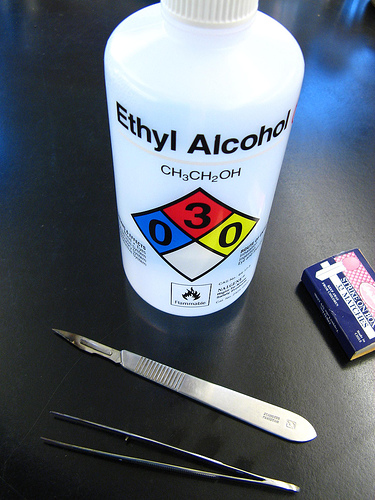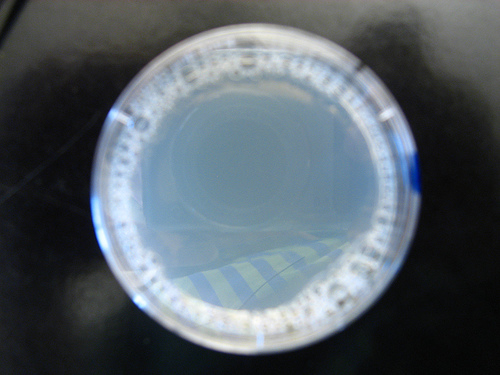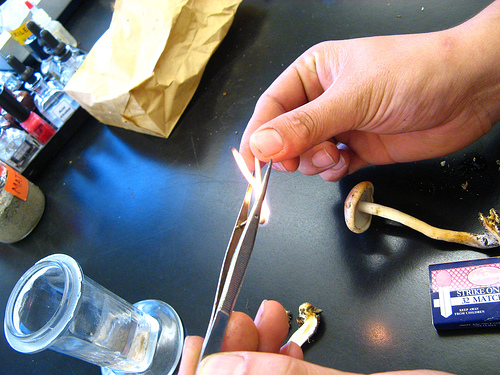Taming The Fungus
 To many of us the fungus is a strange and elusive organism, mysteriously appearing from its substrate, and then suddenly disappearing back into the mass from which it arose. The diversity of fungal shapes and sizes combined with the wide array of substrates from which they fruit, has often created the illusion that fungi come and go as they please. However, with a little knowledge about the biology and ecology of these organisms, one can often capture and cultivate a fungus found growing in the wild.
To many of us the fungus is a strange and elusive organism, mysteriously appearing from its substrate, and then suddenly disappearing back into the mass from which it arose. The diversity of fungal shapes and sizes combined with the wide array of substrates from which they fruit, has often created the illusion that fungi come and go as they please. However, with a little knowledge about the biology and ecology of these organisms, one can often capture and cultivate a fungus found growing in the wild.
The first step to growing your fungus is obtaining a specimen. You can culture molds if you like, but I’m betting that most of you are more interested in growing mushrooms. Find a fresh mushroom that hasn’t begun to show any signs of decay–younger mushrooms are preferred, as the fungus is still actively growing. Typically mushrooms must be cultured within 24 to 48 hours of being picked, and until you can get to them it’s a good idea to store them in your refrigerator. I have chosen to culture this prime specimen of Hypholoma sublateritium, which I found growing in a nearby forest (see our previous story on this “edible?” fungus).
 Now you will want some tools. These include a bottle of alcohol (ethanol or isopropanol), some matches, a scalpel, a pair of tweezers or forceps (finer is better), and a few Petri dishes of potato dextrose agar (PDA). PDA is kind of like Jell-O™ made from boiled potato water. Instead of gelatin (which most fungi can digest), indigestible agar creates the gelatinous nature of this substance, and the potato water and sugar serve to feed the fungus as it grows in culture (you can make PDA yourself1,2 with some potatoes and sugar, agar you buy from an Asian grocer, some mason jars, and a pressure cooker as a sterilizer). While you’re gathering tools, don’t forget a notebook. It is also a good idea to record some notes about your fungus, include where and when you found it, what it was growing on, and any other characteristics that seem unique or important. You’ll be amazed at how quickly you forget this type of information if you don’t record it, and how useful it can be in identifying your fungus.
Now you will want some tools. These include a bottle of alcohol (ethanol or isopropanol), some matches, a scalpel, a pair of tweezers or forceps (finer is better), and a few Petri dishes of potato dextrose agar (PDA). PDA is kind of like Jell-O™ made from boiled potato water. Instead of gelatin (which most fungi can digest), indigestible agar creates the gelatinous nature of this substance, and the potato water and sugar serve to feed the fungus as it grows in culture (you can make PDA yourself1,2 with some potatoes and sugar, agar you buy from an Asian grocer, some mason jars, and a pressure cooker as a sterilizer). While you’re gathering tools, don’t forget a notebook. It is also a good idea to record some notes about your fungus, include where and when you found it, what it was growing on, and any other characteristics that seem unique or important. You’ll be amazed at how quickly you forget this type of information if you don’t record it, and how useful it can be in identifying your fungus.
One of the greatest difficulties of culturing any fungus is dealing with contaminants. Contaminants are weeds–other organisms that want to get in your Petri dishes so they can eat your media first. Fungal spores and bacteria spores are so small that a cubic meter of air may contain thousands of them. That’s why it is very important to work in a clean environment with still air, and to sterilize your tools before use. Some people make a special “glove box” designed to provide a pocket of clean air, but this isn’t a necessity. Although your Petri dishes of PDA must be sterilized in a pressure cooker or autoclave, many of your other tools can quickly be sterilized by dipping them in alcohol and then flaming it off with a match or lighter.

Once you have gathered all of your supplies and are ready to work, the first thing you must do is sterilize your tool of choice: at left I am flaming the remaining alcohol from my tweezers. Immediately after this, use your fingers to tear the mushroom in half, exposing its internal tissue. Be sure not to cut the mushroom open with a blade, as this will drag contaminants from the outer surface of the mushroom to the more sterile tissue within it.
Now use the tweezers to pluck a teeny tiny piece of tissue from the newly revealed inside of the stem or cap, and then quickly place it in the center of your Petri dish. Seal the dish with tape or parafilm, and voila! you have captured your fungus in culture. The mycelium that will grow from your tiny piece is a genetically identical to the parent mushroom. You may have inadvertently captured a few other things, too, so I like to set up three or four dishes–this way I am more likely to get a culture without any contaminants.
 Within several days to a week you should begin to see the first signs of growth, as mycelium grows outward from the piece of tissue in the dish. You’ll want to transfer a teeny tiny chunk taken from the edge of that colony to a new Petri dish, to make sure it’s contaminant-free. The appearance of this mycelium varies greatly depending on the species of fungus that you are culturing. This can make it difficult to spot contaminants if it is your first time culturing that species. Any colony that arises elsewhere on the plate is probably a contaminant that arose from a single spore deposited in air. Slimy, mucusy colonies might be yeasts or bacteria. Anything blue or green is most unwelcome.
Within several days to a week you should begin to see the first signs of growth, as mycelium grows outward from the piece of tissue in the dish. You’ll want to transfer a teeny tiny chunk taken from the edge of that colony to a new Petri dish, to make sure it’s contaminant-free. The appearance of this mycelium varies greatly depending on the species of fungus that you are culturing. This can make it difficult to spot contaminants if it is your first time culturing that species. Any colony that arises elsewhere on the plate is probably a contaminant that arose from a single spore deposited in air. Slimy, mucusy colonies might be yeasts or bacteria. Anything blue or green is most unwelcome.
Capturing your fungus in culture is the first, essential step in mushroom cultivation. I hope we’ll talk more about this another time, but for now I’ll refer you to an expert: If you are interested in learning more about mushroom tissue culture and the contaminants you will encounter, The Mushroom Cultivator, by Paul Stamets, is a great book.
Stamets, P. 2000. Growing Gourmet and Medicinal Mushrooms, 3rd Edition. Ten Speed Press.
Notes:
- Chris Hardwick of Caps and Stems provides a nice illustrated guide to home mushroom cultivation that includes a “foolproof” recipe for PDA. See here.
- And note that you don’t have to make PDA, which is a laboratory standard. Fungi will grow on lots of things. A medium made from V-8 juice and another made from malt extract are popular among the fungi in my lab. –Ed.



A very interesting post. I like reading about how scientists work, not just about their results.
I have in my town a lot of this mushrooms. This is a great site with info
Thanks for the info. Makes me look at mushrooms in a different way now!
I might try this. We have some quite unique fungi here and they would be worth cultivating.